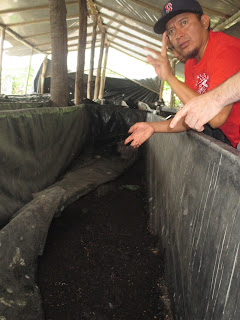Out of all the tours I have taken, I think I have learned the most from this one.
First our guía explained that the red beans are the ones that are actually ripe. A coffee plant produces for about 6-7 years. Then it is cut off at the base of the plant. In another 2 years, it will grow & produce more coffee beans.
How the Coffee Operation Works:
1. First they are sorted manually. 2. Then they are put through this first machine that takes off a shell. 3. These are the coffee bean's shells which are used in the compost.
Papa Co (es mi abuelo) front & center in this photo! He is in his late 60's, smokes half a pack a day, works at a variety of "nearby farms" and often brings coffee & other products to our family at a considerably reduced price.

4. Here is the compost pile which they had on sight. We also learned that they have a huge farm about an hour away with only compost (I.E: dirt & worms)

5. Then the coffee beans go to two separate troughs: one for organic & the other for regular. 25% of the coffee they produce goes to Germany/ Europe which is the organic. The other 75% which isn't organic goes to the U.S./ Canada.
Fun Fact: Every pueblos around the lake produces cafe. San Pedro is the only one that has the official organic title.
Depressing Fact: Very little stays in Guatemala because the locals cannot afford to buy/drink it.
6. It goes through this machine which I think takes off another shell (I know that from start to finish two shells need to come off.)
7. After this machine, it sits in water for a while. The beans that float are separated & not used because they aren't good.
8. The ones that make it through this whole process dry on this court, or cancha, until they are packaged.
ECCL: 2:24-25 "A man can do nothing better than to eat and drink and find satisfaction in his work. This too I see is from the hand of God. For without him, who can eat or find enjoyment?"














2 comments:
This makes a non coffee drinker want to have a cup! thanks for teaching us about the process. love, mom
Elizabeth! I will enjoy my next cup of coffee with a much greater appreciation. So interesting to learn about the time and labor that goes into my morning cup.
Thanks for sharing your adventures with us. I love reading your blog and it's always a treat to find a new post!
I love you, Tia!
Post a Comment